Benchmark Report: Change Initiative Implementation and Evaluation
VerifiedAdded on 2022/08/12
|10
|2229
|295
Report
AI Summary
This report provides a comprehensive analysis of a change initiative implemented in a healthcare setting, specifically Eastern State Hospital, to improve communication among nurses and enhance patient care. The report identifies the need for change, driven by internal and external forces such as customer demands, technological advancements, and competition. It evaluates the impact on stakeholders, including nurses, patients, and management, and discusses the role of leaders and change agents in the process. The application of Lewin's change management model is explored, outlining strategies for unfreezing, changing, and refreezing the organizational structure. The report addresses potential barriers to change and proposes evaluation methods, including surveys, record checks, and focus group interviews. Strategies for sustaining change, such as constant information flow and providing support to nurses, are also presented. The report concludes by emphasizing the overall effectiveness of the change plan, highlighting the importance of effective communication in improving patient care and increasing the proficiency of nurses, ultimately leading to increased profits for the hospital.
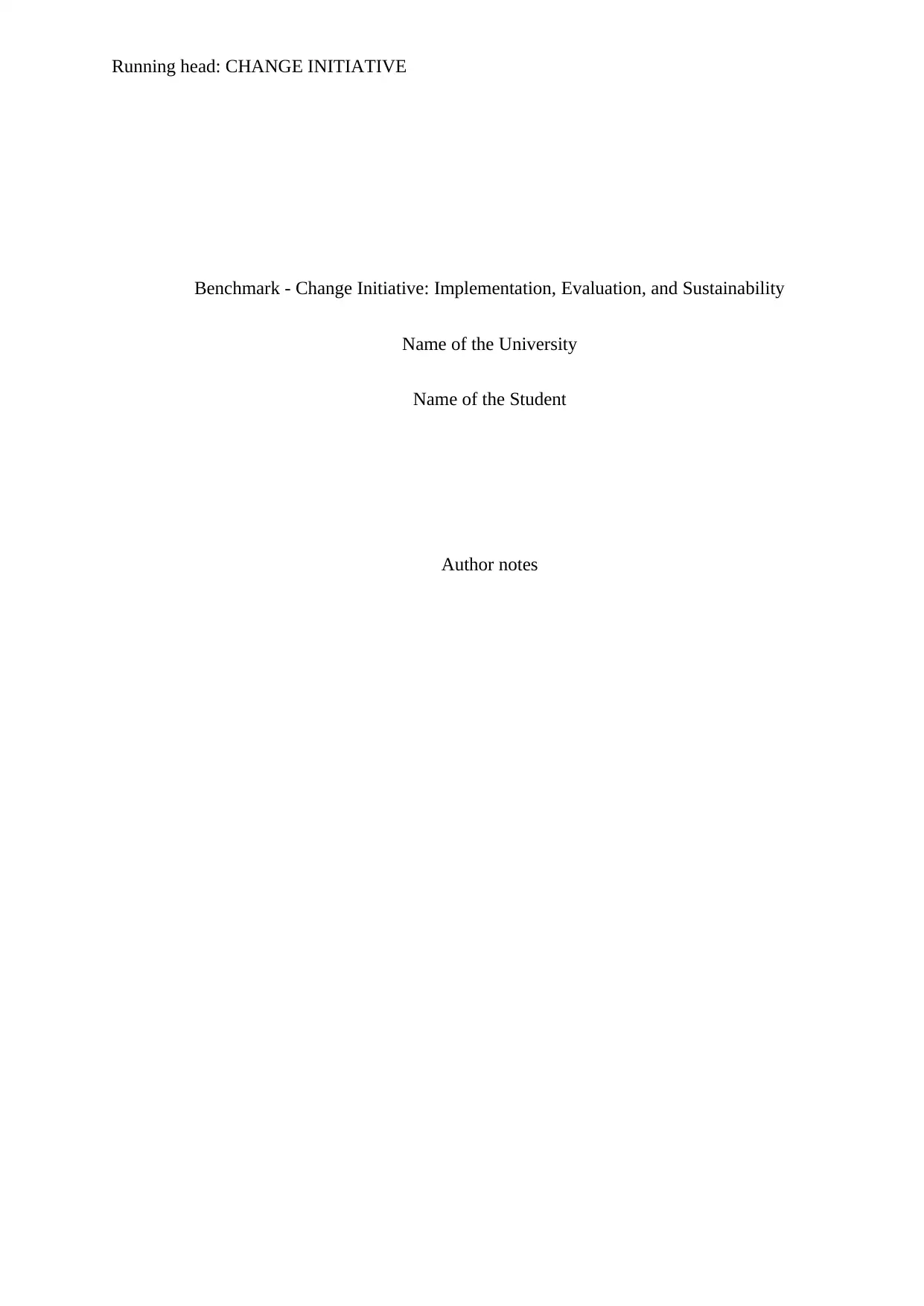
Running head: CHANGE INITIATIVE
Benchmark - Change Initiative: Implementation, Evaluation, and Sustainability
Name of the University
Name of the Student
Author notes
Benchmark - Change Initiative: Implementation, Evaluation, and Sustainability
Name of the University
Name of the Student
Author notes
Paraphrase This Document
Need a fresh take? Get an instant paraphrase of this document with our AI Paraphraser
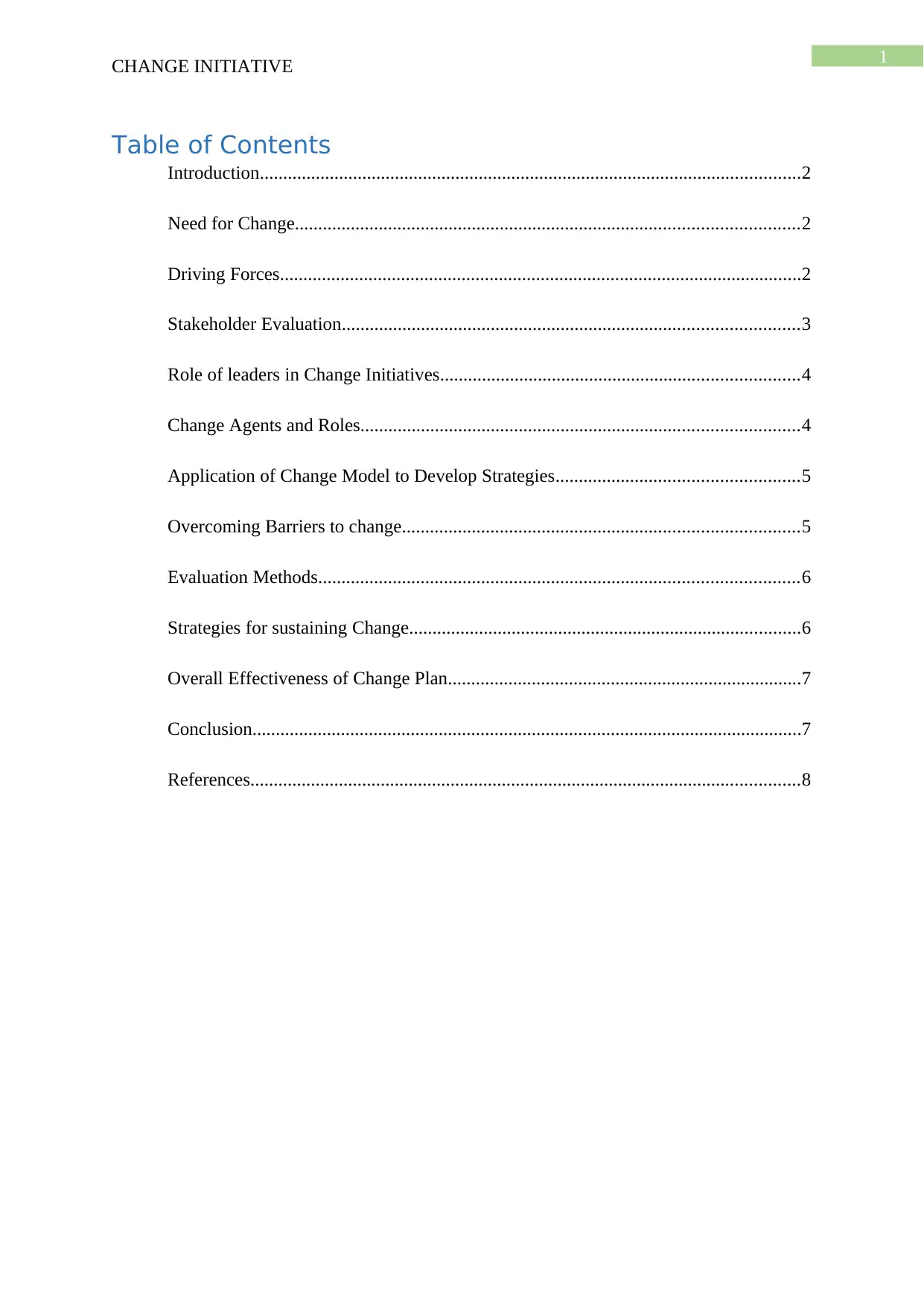
1
CHANGE INITIATIVE
Table of Contents
Introduction....................................................................................................................2
Need for Change............................................................................................................2
Driving Forces................................................................................................................2
Stakeholder Evaluation..................................................................................................3
Role of leaders in Change Initiatives.............................................................................4
Change Agents and Roles..............................................................................................4
Application of Change Model to Develop Strategies....................................................5
Overcoming Barriers to change.....................................................................................5
Evaluation Methods.......................................................................................................6
Strategies for sustaining Change....................................................................................6
Overall Effectiveness of Change Plan............................................................................7
Conclusion......................................................................................................................7
References......................................................................................................................8
CHANGE INITIATIVE
Table of Contents
Introduction....................................................................................................................2
Need for Change............................................................................................................2
Driving Forces................................................................................................................2
Stakeholder Evaluation..................................................................................................3
Role of leaders in Change Initiatives.............................................................................4
Change Agents and Roles..............................................................................................4
Application of Change Model to Develop Strategies....................................................5
Overcoming Barriers to change.....................................................................................5
Evaluation Methods.......................................................................................................6
Strategies for sustaining Change....................................................................................6
Overall Effectiveness of Change Plan............................................................................7
Conclusion......................................................................................................................7
References......................................................................................................................8
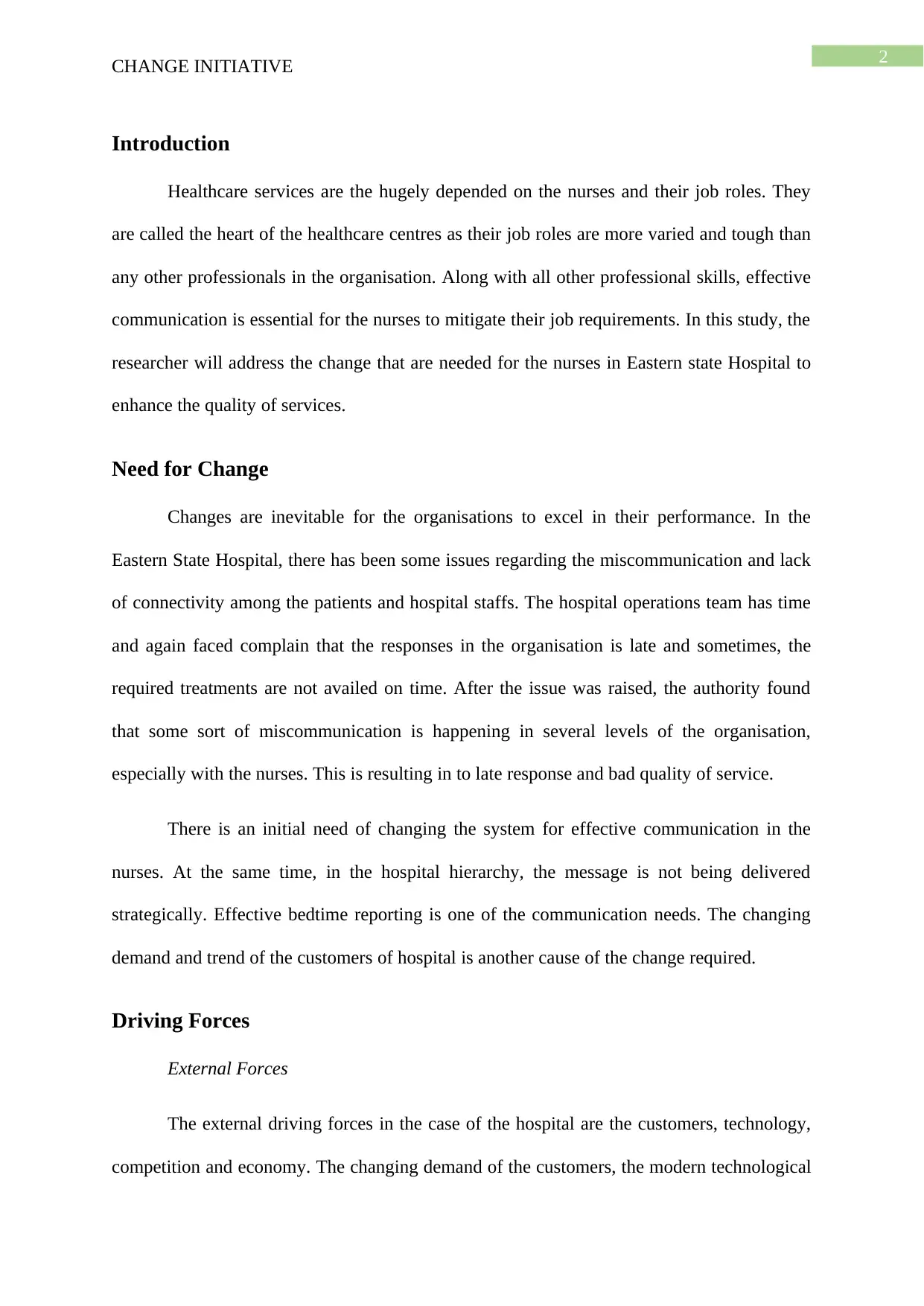
2
CHANGE INITIATIVE
Introduction
Healthcare services are the hugely depended on the nurses and their job roles. They
are called the heart of the healthcare centres as their job roles are more varied and tough than
any other professionals in the organisation. Along with all other professional skills, effective
communication is essential for the nurses to mitigate their job requirements. In this study, the
researcher will address the change that are needed for the nurses in Eastern state Hospital to
enhance the quality of services.
Need for Change
Changes are inevitable for the organisations to excel in their performance. In the
Eastern State Hospital, there has been some issues regarding the miscommunication and lack
of connectivity among the patients and hospital staffs. The hospital operations team has time
and again faced complain that the responses in the organisation is late and sometimes, the
required treatments are not availed on time. After the issue was raised, the authority found
that some sort of miscommunication is happening in several levels of the organisation,
especially with the nurses. This is resulting in to late response and bad quality of service.
There is an initial need of changing the system for effective communication in the
nurses. At the same time, in the hospital hierarchy, the message is not being delivered
strategically. Effective bedtime reporting is one of the communication needs. The changing
demand and trend of the customers of hospital is another cause of the change required.
Driving Forces
External Forces
The external driving forces in the case of the hospital are the customers, technology,
competition and economy. The changing demand of the customers, the modern technological
CHANGE INITIATIVE
Introduction
Healthcare services are the hugely depended on the nurses and their job roles. They
are called the heart of the healthcare centres as their job roles are more varied and tough than
any other professionals in the organisation. Along with all other professional skills, effective
communication is essential for the nurses to mitigate their job requirements. In this study, the
researcher will address the change that are needed for the nurses in Eastern state Hospital to
enhance the quality of services.
Need for Change
Changes are inevitable for the organisations to excel in their performance. In the
Eastern State Hospital, there has been some issues regarding the miscommunication and lack
of connectivity among the patients and hospital staffs. The hospital operations team has time
and again faced complain that the responses in the organisation is late and sometimes, the
required treatments are not availed on time. After the issue was raised, the authority found
that some sort of miscommunication is happening in several levels of the organisation,
especially with the nurses. This is resulting in to late response and bad quality of service.
There is an initial need of changing the system for effective communication in the
nurses. At the same time, in the hospital hierarchy, the message is not being delivered
strategically. Effective bedtime reporting is one of the communication needs. The changing
demand and trend of the customers of hospital is another cause of the change required.
Driving Forces
External Forces
The external driving forces in the case of the hospital are the customers, technology,
competition and economy. The changing demand of the customers, the modern technological
⊘ This is a preview!⊘
Do you want full access?
Subscribe today to unlock all pages.

Trusted by 1+ million students worldwide
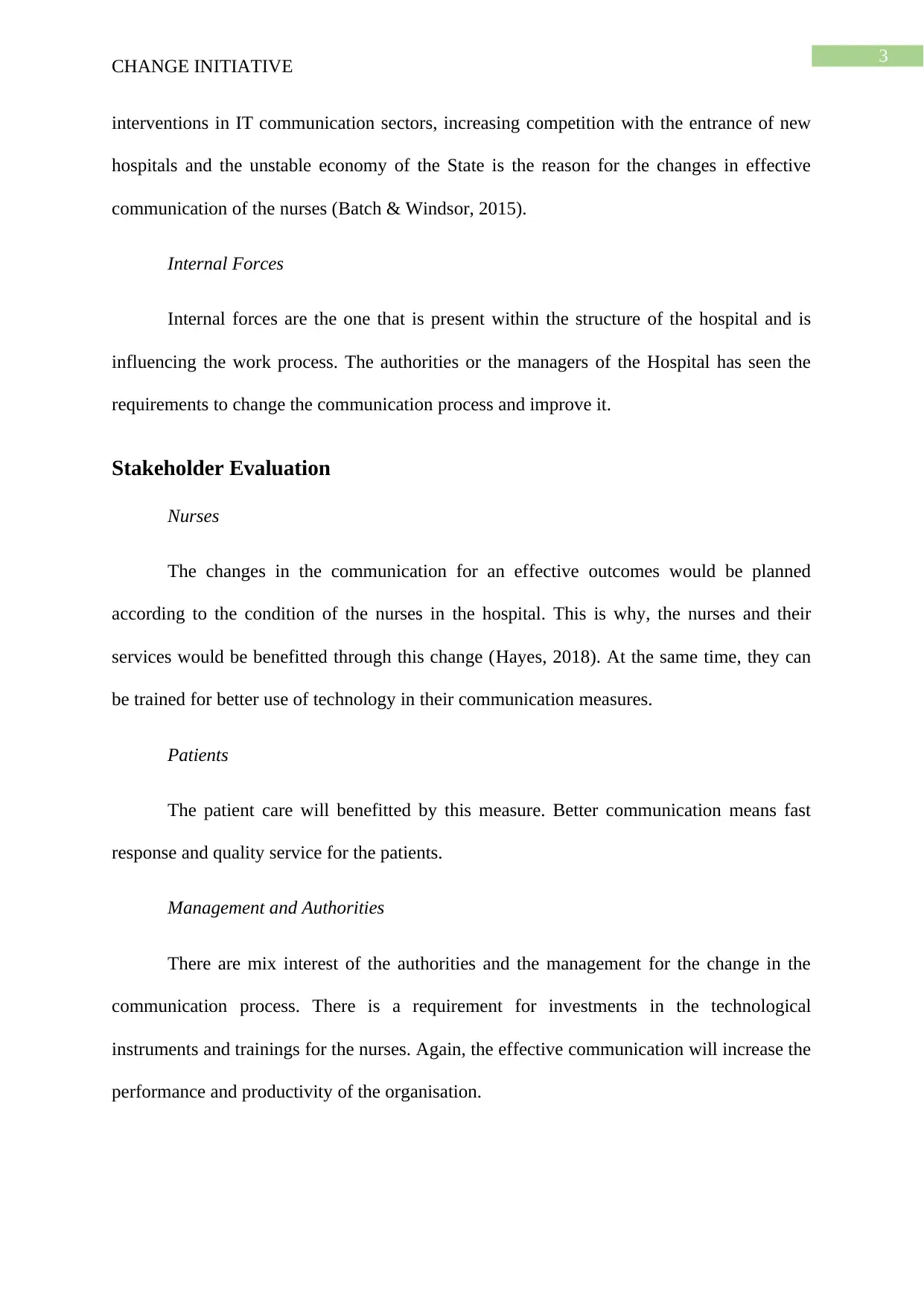
3
CHANGE INITIATIVE
interventions in IT communication sectors, increasing competition with the entrance of new
hospitals and the unstable economy of the State is the reason for the changes in effective
communication of the nurses (Batch & Windsor, 2015).
Internal Forces
Internal forces are the one that is present within the structure of the hospital and is
influencing the work process. The authorities or the managers of the Hospital has seen the
requirements to change the communication process and improve it.
Stakeholder Evaluation
Nurses
The changes in the communication for an effective outcomes would be planned
according to the condition of the nurses in the hospital. This is why, the nurses and their
services would be benefitted through this change (Hayes, 2018). At the same time, they can
be trained for better use of technology in their communication measures.
Patients
The patient care will benefitted by this measure. Better communication means fast
response and quality service for the patients.
Management and Authorities
There are mix interest of the authorities and the management for the change in the
communication process. There is a requirement for investments in the technological
instruments and trainings for the nurses. Again, the effective communication will increase the
performance and productivity of the organisation.
CHANGE INITIATIVE
interventions in IT communication sectors, increasing competition with the entrance of new
hospitals and the unstable economy of the State is the reason for the changes in effective
communication of the nurses (Batch & Windsor, 2015).
Internal Forces
Internal forces are the one that is present within the structure of the hospital and is
influencing the work process. The authorities or the managers of the Hospital has seen the
requirements to change the communication process and improve it.
Stakeholder Evaluation
Nurses
The changes in the communication for an effective outcomes would be planned
according to the condition of the nurses in the hospital. This is why, the nurses and their
services would be benefitted through this change (Hayes, 2018). At the same time, they can
be trained for better use of technology in their communication measures.
Patients
The patient care will benefitted by this measure. Better communication means fast
response and quality service for the patients.
Management and Authorities
There are mix interest of the authorities and the management for the change in the
communication process. There is a requirement for investments in the technological
instruments and trainings for the nurses. Again, the effective communication will increase the
performance and productivity of the organisation.
Paraphrase This Document
Need a fresh take? Get an instant paraphrase of this document with our AI Paraphraser
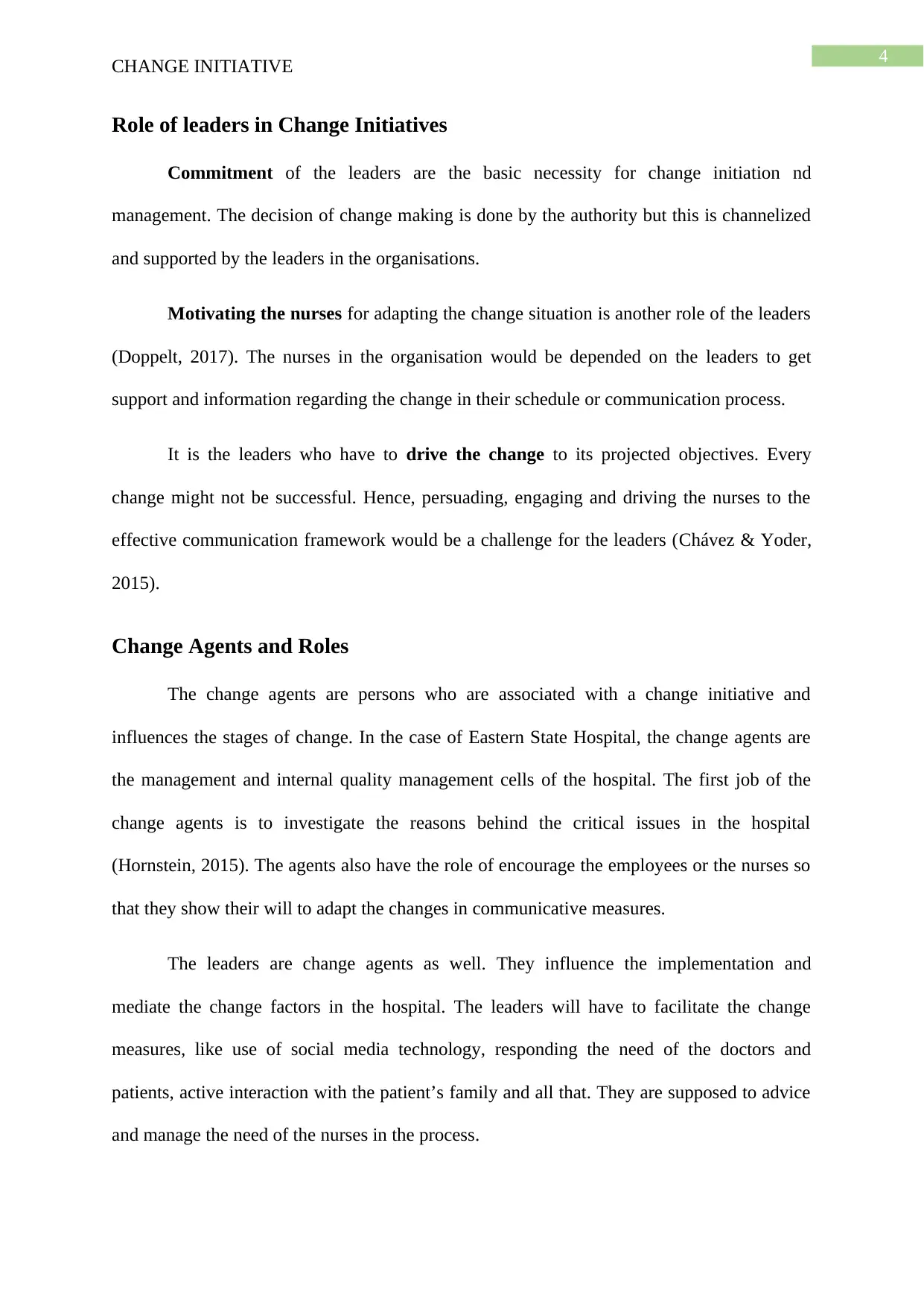
4
CHANGE INITIATIVE
Role of leaders in Change Initiatives
Commitment of the leaders are the basic necessity for change initiation nd
management. The decision of change making is done by the authority but this is channelized
and supported by the leaders in the organisations.
Motivating the nurses for adapting the change situation is another role of the leaders
(Doppelt, 2017). The nurses in the organisation would be depended on the leaders to get
support and information regarding the change in their schedule or communication process.
It is the leaders who have to drive the change to its projected objectives. Every
change might not be successful. Hence, persuading, engaging and driving the nurses to the
effective communication framework would be a challenge for the leaders (Chávez & Yoder,
2015).
Change Agents and Roles
The change agents are persons who are associated with a change initiative and
influences the stages of change. In the case of Eastern State Hospital, the change agents are
the management and internal quality management cells of the hospital. The first job of the
change agents is to investigate the reasons behind the critical issues in the hospital
(Hornstein, 2015). The agents also have the role of encourage the employees or the nurses so
that they show their will to adapt the changes in communicative measures.
The leaders are change agents as well. They influence the implementation and
mediate the change factors in the hospital. The leaders will have to facilitate the change
measures, like use of social media technology, responding the need of the doctors and
patients, active interaction with the patient’s family and all that. They are supposed to advice
and manage the need of the nurses in the process.
CHANGE INITIATIVE
Role of leaders in Change Initiatives
Commitment of the leaders are the basic necessity for change initiation nd
management. The decision of change making is done by the authority but this is channelized
and supported by the leaders in the organisations.
Motivating the nurses for adapting the change situation is another role of the leaders
(Doppelt, 2017). The nurses in the organisation would be depended on the leaders to get
support and information regarding the change in their schedule or communication process.
It is the leaders who have to drive the change to its projected objectives. Every
change might not be successful. Hence, persuading, engaging and driving the nurses to the
effective communication framework would be a challenge for the leaders (Chávez & Yoder,
2015).
Change Agents and Roles
The change agents are persons who are associated with a change initiative and
influences the stages of change. In the case of Eastern State Hospital, the change agents are
the management and internal quality management cells of the hospital. The first job of the
change agents is to investigate the reasons behind the critical issues in the hospital
(Hornstein, 2015). The agents also have the role of encourage the employees or the nurses so
that they show their will to adapt the changes in communicative measures.
The leaders are change agents as well. They influence the implementation and
mediate the change factors in the hospital. The leaders will have to facilitate the change
measures, like use of social media technology, responding the need of the doctors and
patients, active interaction with the patient’s family and all that. They are supposed to advice
and manage the need of the nurses in the process.
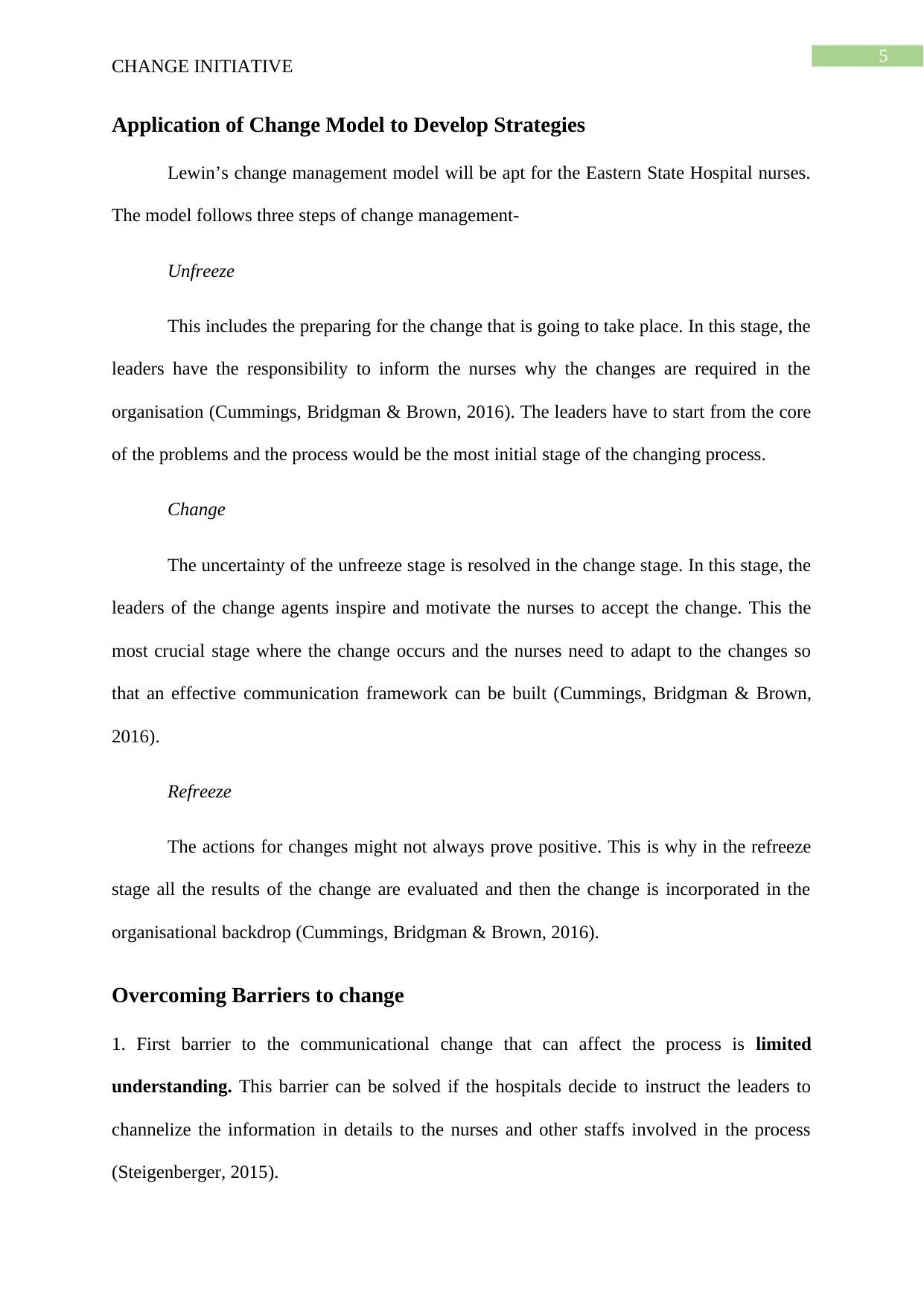
5
CHANGE INITIATIVE
Application of Change Model to Develop Strategies
Lewin’s change management model will be apt for the Eastern State Hospital nurses.
The model follows three steps of change management-
Unfreeze
This includes the preparing for the change that is going to take place. In this stage, the
leaders have the responsibility to inform the nurses why the changes are required in the
organisation (Cummings, Bridgman & Brown, 2016). The leaders have to start from the core
of the problems and the process would be the most initial stage of the changing process.
Change
The uncertainty of the unfreeze stage is resolved in the change stage. In this stage, the
leaders of the change agents inspire and motivate the nurses to accept the change. This the
most crucial stage where the change occurs and the nurses need to adapt to the changes so
that an effective communication framework can be built (Cummings, Bridgman & Brown,
2016).
Refreeze
The actions for changes might not always prove positive. This is why in the refreeze
stage all the results of the change are evaluated and then the change is incorporated in the
organisational backdrop (Cummings, Bridgman & Brown, 2016).
Overcoming Barriers to change
1. First barrier to the communicational change that can affect the process is limited
understanding. This barrier can be solved if the hospitals decide to instruct the leaders to
channelize the information in details to the nurses and other staffs involved in the process
(Steigenberger, 2015).
CHANGE INITIATIVE
Application of Change Model to Develop Strategies
Lewin’s change management model will be apt for the Eastern State Hospital nurses.
The model follows three steps of change management-
Unfreeze
This includes the preparing for the change that is going to take place. In this stage, the
leaders have the responsibility to inform the nurses why the changes are required in the
organisation (Cummings, Bridgman & Brown, 2016). The leaders have to start from the core
of the problems and the process would be the most initial stage of the changing process.
Change
The uncertainty of the unfreeze stage is resolved in the change stage. In this stage, the
leaders of the change agents inspire and motivate the nurses to accept the change. This the
most crucial stage where the change occurs and the nurses need to adapt to the changes so
that an effective communication framework can be built (Cummings, Bridgman & Brown,
2016).
Refreeze
The actions for changes might not always prove positive. This is why in the refreeze
stage all the results of the change are evaluated and then the change is incorporated in the
organisational backdrop (Cummings, Bridgman & Brown, 2016).
Overcoming Barriers to change
1. First barrier to the communicational change that can affect the process is limited
understanding. This barrier can be solved if the hospitals decide to instruct the leaders to
channelize the information in details to the nurses and other staffs involved in the process
(Steigenberger, 2015).
⊘ This is a preview!⊘
Do you want full access?
Subscribe today to unlock all pages.

Trusted by 1+ million students worldwide
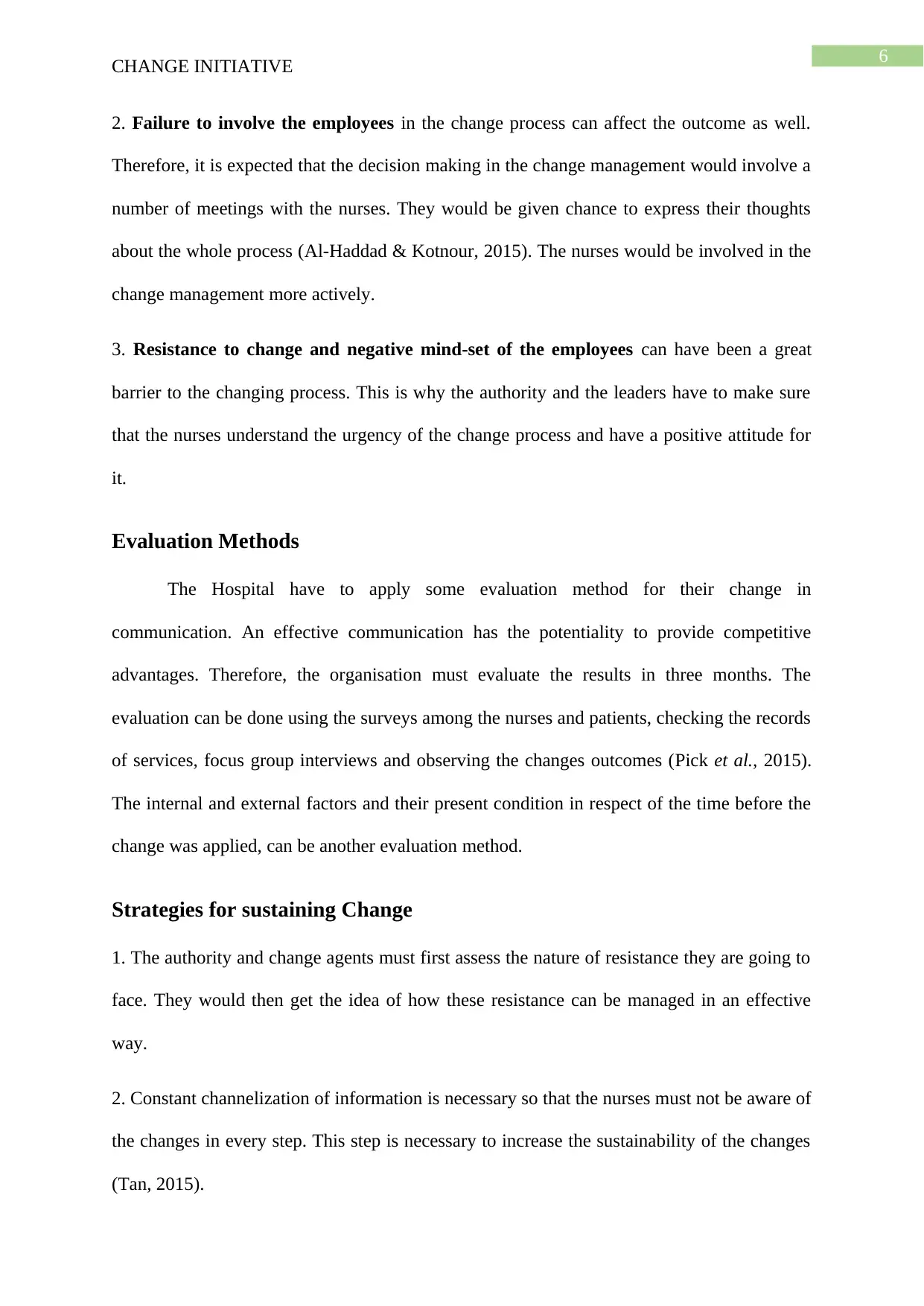
6
CHANGE INITIATIVE
2. Failure to involve the employees in the change process can affect the outcome as well.
Therefore, it is expected that the decision making in the change management would involve a
number of meetings with the nurses. They would be given chance to express their thoughts
about the whole process (Al-Haddad & Kotnour, 2015). The nurses would be involved in the
change management more actively.
3. Resistance to change and negative mind-set of the employees can have been a great
barrier to the changing process. This is why the authority and the leaders have to make sure
that the nurses understand the urgency of the change process and have a positive attitude for
it.
Evaluation Methods
The Hospital have to apply some evaluation method for their change in
communication. An effective communication has the potentiality to provide competitive
advantages. Therefore, the organisation must evaluate the results in three months. The
evaluation can be done using the surveys among the nurses and patients, checking the records
of services, focus group interviews and observing the changes outcomes (Pick et al., 2015).
The internal and external factors and their present condition in respect of the time before the
change was applied, can be another evaluation method.
Strategies for sustaining Change
1. The authority and change agents must first assess the nature of resistance they are going to
face. They would then get the idea of how these resistance can be managed in an effective
way.
2. Constant channelization of information is necessary so that the nurses must not be aware of
the changes in every step. This step is necessary to increase the sustainability of the changes
(Tan, 2015).
CHANGE INITIATIVE
2. Failure to involve the employees in the change process can affect the outcome as well.
Therefore, it is expected that the decision making in the change management would involve a
number of meetings with the nurses. They would be given chance to express their thoughts
about the whole process (Al-Haddad & Kotnour, 2015). The nurses would be involved in the
change management more actively.
3. Resistance to change and negative mind-set of the employees can have been a great
barrier to the changing process. This is why the authority and the leaders have to make sure
that the nurses understand the urgency of the change process and have a positive attitude for
it.
Evaluation Methods
The Hospital have to apply some evaluation method for their change in
communication. An effective communication has the potentiality to provide competitive
advantages. Therefore, the organisation must evaluate the results in three months. The
evaluation can be done using the surveys among the nurses and patients, checking the records
of services, focus group interviews and observing the changes outcomes (Pick et al., 2015).
The internal and external factors and their present condition in respect of the time before the
change was applied, can be another evaluation method.
Strategies for sustaining Change
1. The authority and change agents must first assess the nature of resistance they are going to
face. They would then get the idea of how these resistance can be managed in an effective
way.
2. Constant channelization of information is necessary so that the nurses must not be aware of
the changes in every step. This step is necessary to increase the sustainability of the changes
(Tan, 2015).
Paraphrase This Document
Need a fresh take? Get an instant paraphrase of this document with our AI Paraphraser
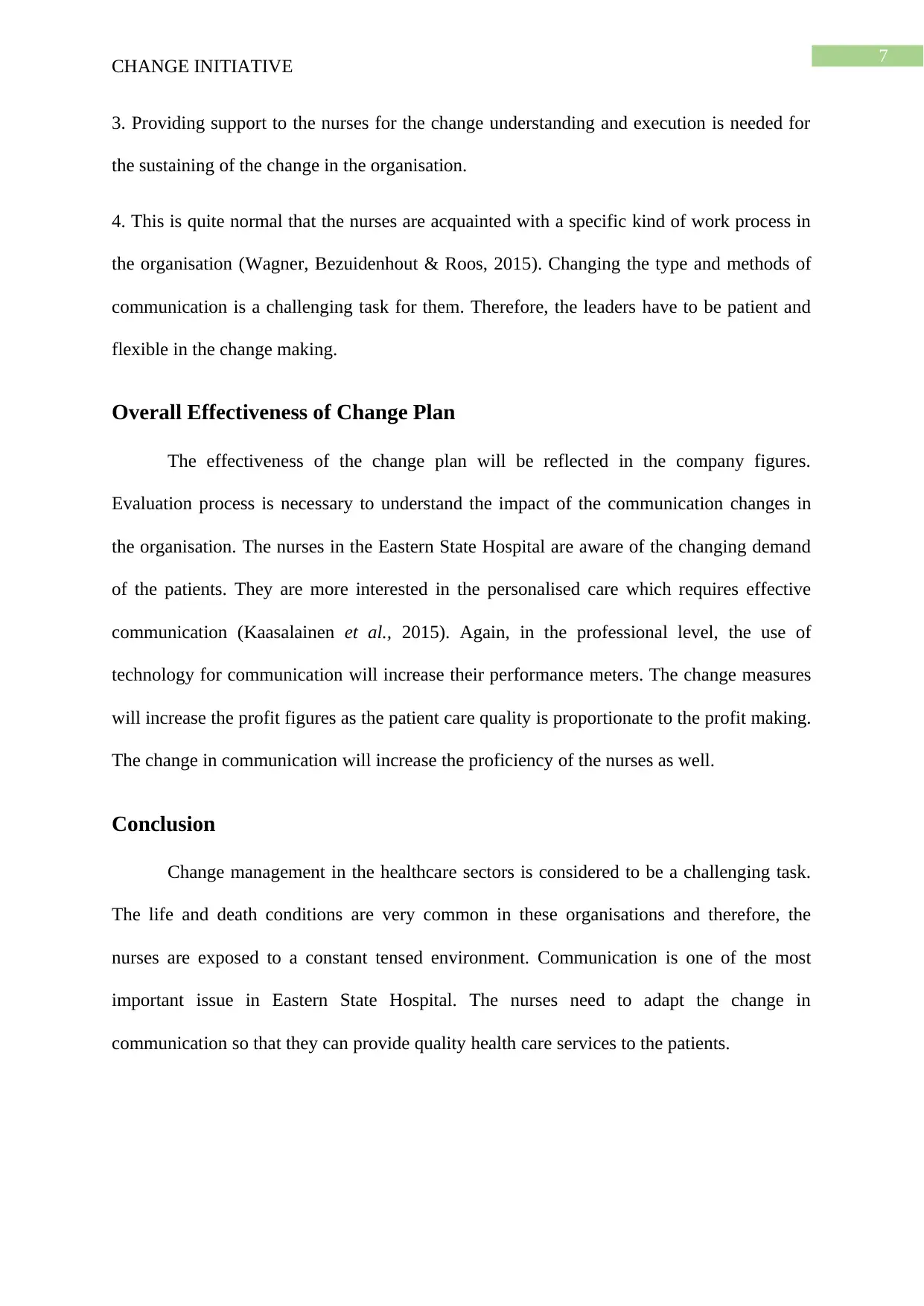
7
CHANGE INITIATIVE
3. Providing support to the nurses for the change understanding and execution is needed for
the sustaining of the change in the organisation.
4. This is quite normal that the nurses are acquainted with a specific kind of work process in
the organisation (Wagner, Bezuidenhout & Roos, 2015). Changing the type and methods of
communication is a challenging task for them. Therefore, the leaders have to be patient and
flexible in the change making.
Overall Effectiveness of Change Plan
The effectiveness of the change plan will be reflected in the company figures.
Evaluation process is necessary to understand the impact of the communication changes in
the organisation. The nurses in the Eastern State Hospital are aware of the changing demand
of the patients. They are more interested in the personalised care which requires effective
communication (Kaasalainen et al., 2015). Again, in the professional level, the use of
technology for communication will increase their performance meters. The change measures
will increase the profit figures as the patient care quality is proportionate to the profit making.
The change in communication will increase the proficiency of the nurses as well.
Conclusion
Change management in the healthcare sectors is considered to be a challenging task.
The life and death conditions are very common in these organisations and therefore, the
nurses are exposed to a constant tensed environment. Communication is one of the most
important issue in Eastern State Hospital. The nurses need to adapt the change in
communication so that they can provide quality health care services to the patients.
CHANGE INITIATIVE
3. Providing support to the nurses for the change understanding and execution is needed for
the sustaining of the change in the organisation.
4. This is quite normal that the nurses are acquainted with a specific kind of work process in
the organisation (Wagner, Bezuidenhout & Roos, 2015). Changing the type and methods of
communication is a challenging task for them. Therefore, the leaders have to be patient and
flexible in the change making.
Overall Effectiveness of Change Plan
The effectiveness of the change plan will be reflected in the company figures.
Evaluation process is necessary to understand the impact of the communication changes in
the organisation. The nurses in the Eastern State Hospital are aware of the changing demand
of the patients. They are more interested in the personalised care which requires effective
communication (Kaasalainen et al., 2015). Again, in the professional level, the use of
technology for communication will increase their performance meters. The change measures
will increase the profit figures as the patient care quality is proportionate to the profit making.
The change in communication will increase the proficiency of the nurses as well.
Conclusion
Change management in the healthcare sectors is considered to be a challenging task.
The life and death conditions are very common in these organisations and therefore, the
nurses are exposed to a constant tensed environment. Communication is one of the most
important issue in Eastern State Hospital. The nurses need to adapt the change in
communication so that they can provide quality health care services to the patients.
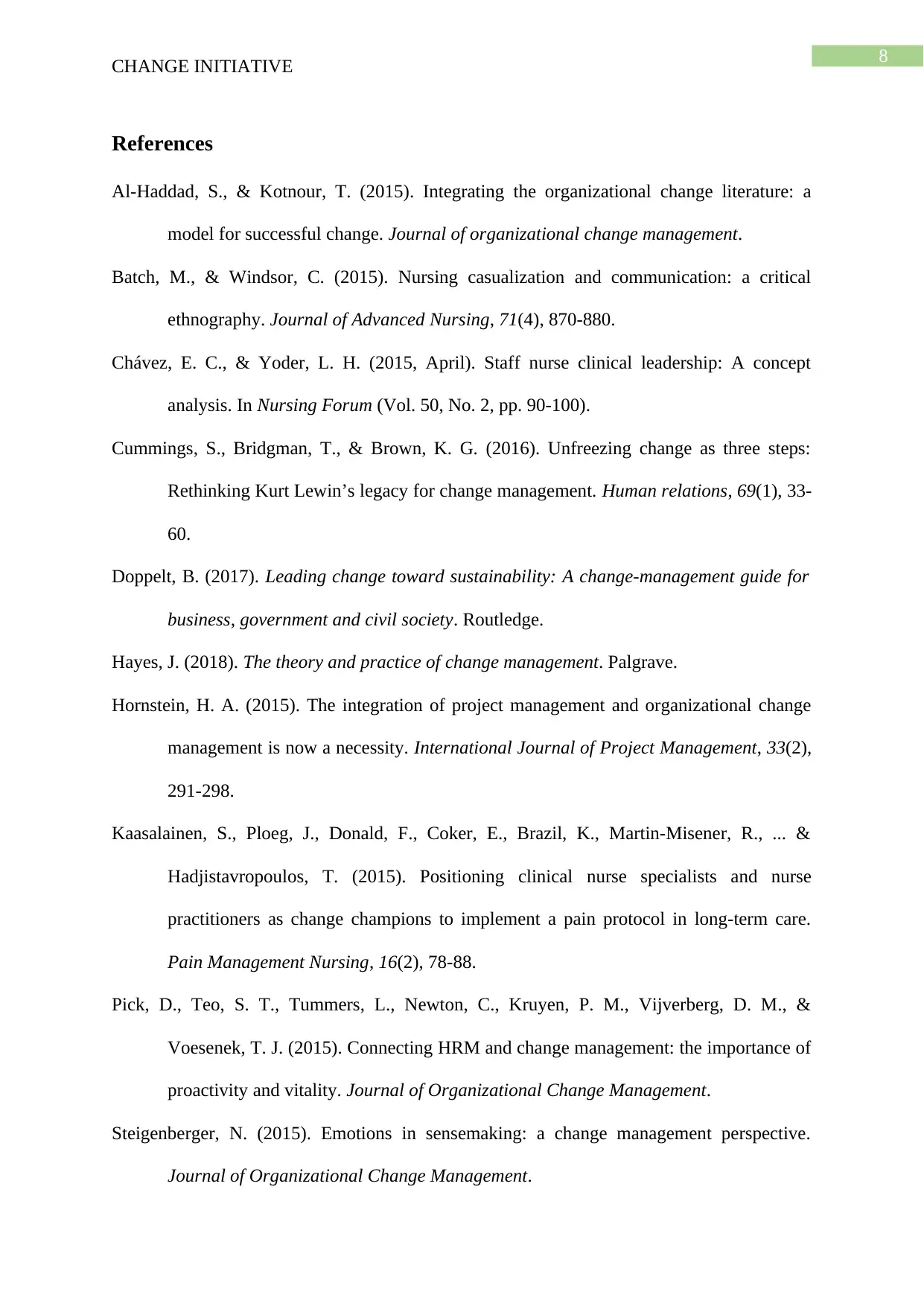
8
CHANGE INITIATIVE
References
Al-Haddad, S., & Kotnour, T. (2015). Integrating the organizational change literature: a
model for successful change. Journal of organizational change management.
Batch, M., & Windsor, C. (2015). Nursing casualization and communication: a critical
ethnography. Journal of Advanced Nursing, 71(4), 870-880.
Chávez, E. C., & Yoder, L. H. (2015, April). Staff nurse clinical leadership: A concept
analysis. In Nursing Forum (Vol. 50, No. 2, pp. 90-100).
Cummings, S., Bridgman, T., & Brown, K. G. (2016). Unfreezing change as three steps:
Rethinking Kurt Lewin’s legacy for change management. Human relations, 69(1), 33-
60.
Doppelt, B. (2017). Leading change toward sustainability: A change-management guide for
business, government and civil society. Routledge.
Hayes, J. (2018). The theory and practice of change management. Palgrave.
Hornstein, H. A. (2015). The integration of project management and organizational change
management is now a necessity. International Journal of Project Management, 33(2),
291-298.
Kaasalainen, S., Ploeg, J., Donald, F., Coker, E., Brazil, K., Martin-Misener, R., ... &
Hadjistavropoulos, T. (2015). Positioning clinical nurse specialists and nurse
practitioners as change champions to implement a pain protocol in long-term care.
Pain Management Nursing, 16(2), 78-88.
Pick, D., Teo, S. T., Tummers, L., Newton, C., Kruyen, P. M., Vijverberg, D. M., &
Voesenek, T. J. (2015). Connecting HRM and change management: the importance of
proactivity and vitality. Journal of Organizational Change Management.
Steigenberger, N. (2015). Emotions in sensemaking: a change management perspective.
Journal of Organizational Change Management.
CHANGE INITIATIVE
References
Al-Haddad, S., & Kotnour, T. (2015). Integrating the organizational change literature: a
model for successful change. Journal of organizational change management.
Batch, M., & Windsor, C. (2015). Nursing casualization and communication: a critical
ethnography. Journal of Advanced Nursing, 71(4), 870-880.
Chávez, E. C., & Yoder, L. H. (2015, April). Staff nurse clinical leadership: A concept
analysis. In Nursing Forum (Vol. 50, No. 2, pp. 90-100).
Cummings, S., Bridgman, T., & Brown, K. G. (2016). Unfreezing change as three steps:
Rethinking Kurt Lewin’s legacy for change management. Human relations, 69(1), 33-
60.
Doppelt, B. (2017). Leading change toward sustainability: A change-management guide for
business, government and civil society. Routledge.
Hayes, J. (2018). The theory and practice of change management. Palgrave.
Hornstein, H. A. (2015). The integration of project management and organizational change
management is now a necessity. International Journal of Project Management, 33(2),
291-298.
Kaasalainen, S., Ploeg, J., Donald, F., Coker, E., Brazil, K., Martin-Misener, R., ... &
Hadjistavropoulos, T. (2015). Positioning clinical nurse specialists and nurse
practitioners as change champions to implement a pain protocol in long-term care.
Pain Management Nursing, 16(2), 78-88.
Pick, D., Teo, S. T., Tummers, L., Newton, C., Kruyen, P. M., Vijverberg, D. M., &
Voesenek, T. J. (2015). Connecting HRM and change management: the importance of
proactivity and vitality. Journal of Organizational Change Management.
Steigenberger, N. (2015). Emotions in sensemaking: a change management perspective.
Journal of Organizational Change Management.
⊘ This is a preview!⊘
Do you want full access?
Subscribe today to unlock all pages.

Trusted by 1+ million students worldwide
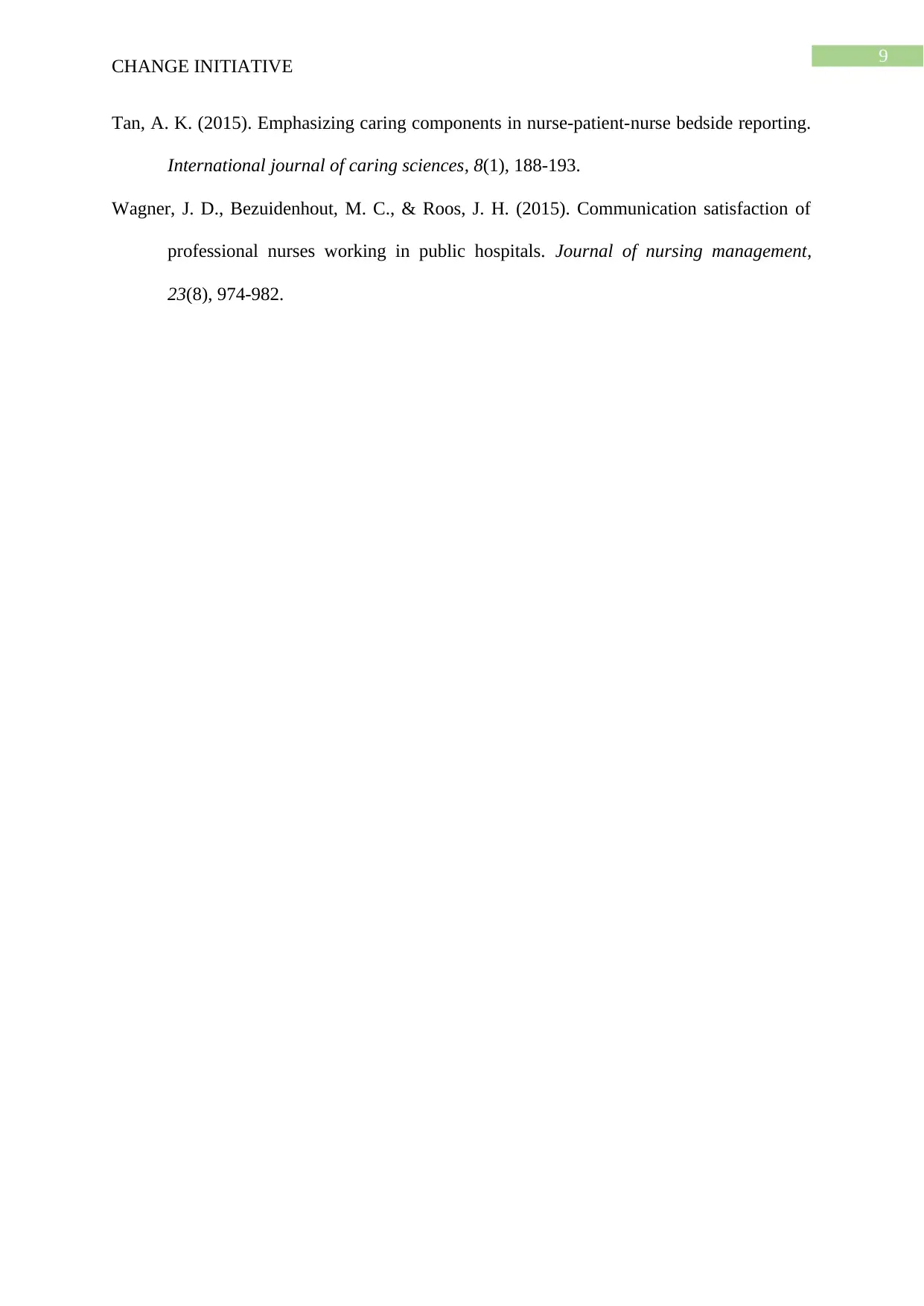
9
CHANGE INITIATIVE
Tan, A. K. (2015). Emphasizing caring components in nurse-patient-nurse bedside reporting.
International journal of caring sciences, 8(1), 188-193.
Wagner, J. D., Bezuidenhout, M. C., & Roos, J. H. (2015). Communication satisfaction of
professional nurses working in public hospitals. Journal of nursing management,
23(8), 974-982.
CHANGE INITIATIVE
Tan, A. K. (2015). Emphasizing caring components in nurse-patient-nurse bedside reporting.
International journal of caring sciences, 8(1), 188-193.
Wagner, J. D., Bezuidenhout, M. C., & Roos, J. H. (2015). Communication satisfaction of
professional nurses working in public hospitals. Journal of nursing management,
23(8), 974-982.
1 out of 10
Related Documents
Your All-in-One AI-Powered Toolkit for Academic Success.
+13062052269
info@desklib.com
Available 24*7 on WhatsApp / Email
![[object Object]](/_next/static/media/star-bottom.7253800d.svg)
Unlock your academic potential
Copyright © 2020–2025 A2Z Services. All Rights Reserved. Developed and managed by ZUCOL.





